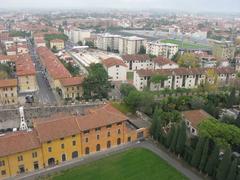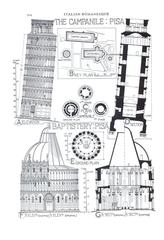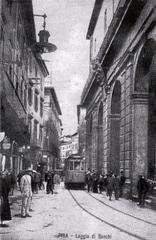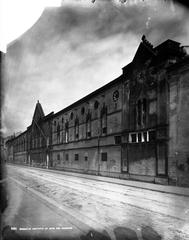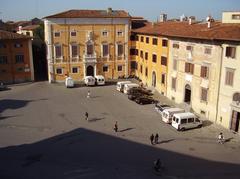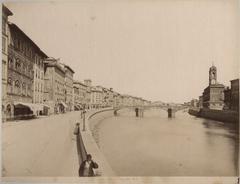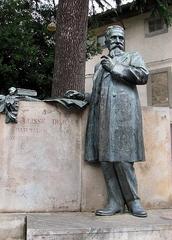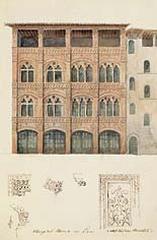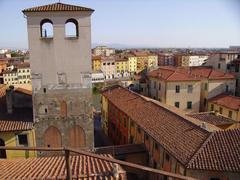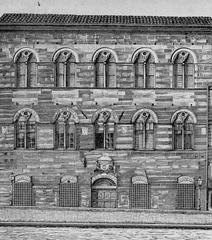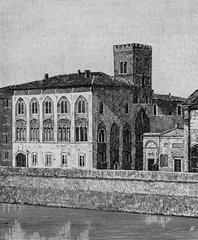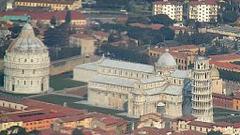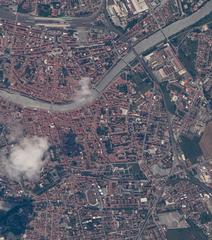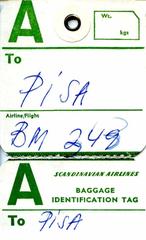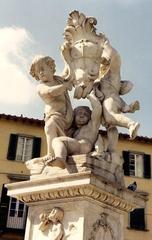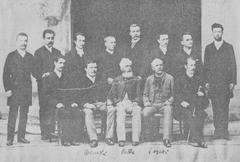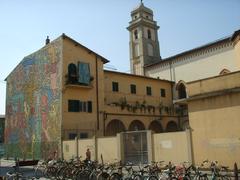Ponte delle Bocchette Pisa: Visiting Hours, Tickets, and Historical Significance Guide
Date: 03/07/2025
Introduction: Discovering Ponte delle Bocchette
Ponte delle Bocchette is a distinctive modern bridge spanning the Arno River in Pisa, Italy. While it may not draw as much global attention as the Leaning Tower or Ponte di Mezzo, this bridge encapsulates Pisa’s blend of historical heritage and contemporary urban planning. Named after the nearby Medici-era brick sluices—or “bocchette”—built in the 16th century to control the Arno’s flooding, the bridge stands as a testament to the city’s centuries-long efforts in hydraulic engineering (Wikipedia - Ponte delle Bocchette; forzapisa.it).
Completed in 1984, Ponte delle Bocchette was designed to enhance traffic flow on Pisa’s eastern bypass, balancing practical utility with a subtle nod to the city’s ongoing relationship with its river. Its robust, utilitarian design contrasts with Pisa’s more ornate medieval structures but serves an essential function in the city’s infrastructure (Corriere Toscano). For visitors, Ponte delle Bocchette offers a unique vantage point for understanding Pisa’s layered history and evolving cityscape.
Contents
- Introduction
- Historical Background
- Architectural Features and Technical Specifications
- Urban and Cultural Significance
- Visiting Information (Hours, Accessibility, Tickets)
- Nearby Attractions and Local Insights
- Photography and Scenic Value
- Frequently Asked Questions (FAQ)
- Conclusion & Recommendations
- References
Historical Background
Ponte delle Bocchette derives its name from the adjacent Medici sluices, or “bocchette,” constructed in the 16th century to manage the Arno’s flow and mitigate flooding—a persistent challenge in Pisa’s history (Wikipedia - Ponte delle Bocchette). The Medici’s hydraulic works were crucial in shaping the city’s urban development and defense.
The current bridge is a product of Pisa’s late 20th-century modernization. Built in the early 1980s and inaugurated in 1984, its construction was a significant civic investment—so much so that locals humorously compared its cost to Diego Maradona’s landmark football transfer. The bridge was engineered to improve traffic circulation, particularly along the city’s eastern bypass, and to provide a reliable passage during periods of high water when older bridges might be closed (forzapisa.it).
Architectural Features and Technical Specifications
Ponte delle Bocchette is 160 meters long and 24 meters wide, featuring four spans (the largest reaching 42 meters) and a maximum height of 18 meters above the river. It is constructed from pre-stressed reinforced concrete, reflecting the late 20th-century focus on structural durability and efficiency.
The bridge’s design prioritizes functionality over ornamentation. Unlike Pisa’s historic bridges, which are often celebrated for their aesthetic flourishes, Ponte delle Bocchette adopts a more understated appearance. Its most distinctive elements are the multiple “bocchette,” or small openings along its sides, providing views of the Arno and the surrounding landscape (Wikipedia - Ponte delle Bocchette).
Urban and Cultural Significance
Strategically, Ponte delle Bocchette is the first bridge over the Arno within Pisa when arriving from the east. It serves as a crucial artery for the eastern ring road (circonvallazione est), alleviating congestion in the city center and ensuring continuity during emergencies or floods (Corriere Toscano). Its proximity to the Medici sluices further deepens its historical resonance, symbolizing Pisa’s enduring engagement with the Arno and its waters.
The bridge also exemplifies Pisa’s pragmatic approach to urban development—balancing modern infrastructure needs with respect for historical context. While it may not be as picturesque as Ponte di Mezzo or Ponte della Vittoria, Ponte delle Bocchette is a vital piece of the city’s contemporary landscape.
Visiting Information
Hours and Tickets
Ponte delle Bocchette is accessible year-round, 24 hours a day, with no entry fees or ticket requirements. It is open to pedestrians, cyclists, and vehicles, making it an inclusive destination for all visitors (bitesizetourist.com).
Getting There & Accessibility
- By car: Connects directly with Pisa’s eastern bypass; ample parking nearby.
- By bicycle: The bridge is part of several cycling routes throughout Pisa.
- By public transport: Local buses serve the area, linking the bridge with the city center.
- For disabled visitors: The bridge is fully accessible, with ramps and wide paths. Standard safety barriers are present, but caution is advised during heavy traffic or inclement weather.
Visitor Tips
- Best times to visit: Early mornings and late afternoons provide ideal light for photography and a quieter experience.
- Safety: Exercise caution during peak traffic hours; the bridge is well-maintained but busy.
- Nearby sights: The Medici sluices, eastern districts of Pisa, and local trattorias. The bridge also serves as a gateway to explore less-touristed neighborhoods like Bocchette (Bitesize Tourist).
Nearby Attractions and Local Insights
Key Historical Sites
- Leaning Tower of Pisa (Torre Pendente): Pisa’s most famous landmark, accessible via a short car, bus, or bike ride from Ponte delle Bocchette (Official Site for Tickets and Info).
- Pisa Cathedral (Duomo di Pisa): Renowned Romanesque church adjacent to the Tower.
- Baptistery of St. John and Camposanto Monumentale: Other highlights in Piazza dei Miracoli.
- Ponte di Mezzo and Ponte della Vittoria: Historic bridges offering further insight into Pisa’s relationship with the Arno (forzapisa.it).
Exploring Bocchette
The Bocchette district, located near the bridge, is a mostly residential area that provides a quieter and more authentic Pisan experience. It’s conveniently situated for easy transport links and offers a range of local dining and accommodation options. Visitors can enjoy traditional Tuscan cuisine in local trattorias, explore community markets, and use Bocchette as a base for guided tours of Pisa’s historic core.
Cultural Events
- Luminara di San Ranieri (June): A festival where thousands of candles light up Pisa’s riverbanks and bridges.
- Gioco del Ponte (June): Historic festival held on Ponte di Mezzo.
- Other events: Regular regattas, concerts, and local markets are easily accessible from the Bocchette area.
Photography and Scenic Value
While Ponte delle Bocchette lacks the ornate beauty of Pisa’s medieval bridges, it offers sweeping views of the Arno and the city’s evolving urban landscape—especially at sunrise and sunset. The bridge’s height and open design provide excellent opportunities for urban and landscape photography. For optimal SEO, use descriptive alt tags such as “Ponte delle Bocchette Pisa at sunset” or “Modern bridge over the Arno River, Pisa.”
Frequently Asked Questions (FAQ)
Q: Is there a fee to visit Ponte delle Bocchette?
A: No, the bridge is free to access and open year-round.
Q: What are the best times to visit?
A: Early morning or late afternoon, particularly in summer, for better light and fewer vehicles.
Q: Is the bridge accessible for those with mobility challenges?
A: Yes, it includes ramps and wide paths suitable for wheelchairs and strollers.
Q: Are there guided tours of Ponte delle Bocchette?
A: No dedicated tours are currently offered, but the bridge can be included in broader city walks or bike tours.
Q: Can I reach the historic Medici sluices from the bridge?
A: Yes, they are a short walk or drive away and offer additional insight into Pisa’s history.
Conclusion & Recommendations
Ponte delle Bocchette is an essential—if understated—part of Pisa’s story, bridging the city’s storied past with its modern present. Its significance lies not only in its function but also in its role as a symbol of Pisa’s resilience and adaptability. For visitors eager to go beyond the typical tourist trail, this bridge offers a window into the city’s ongoing dialogue with its river and its people.
Travel Tips:
- Use the Audiala app for detailed maps, guided tours, and current visitor information.
- Pair a visit to Ponte delle Bocchette with time in the Bocchette district for a taste of local life.
- Combine urban exploration with visits to Pisa’s renowned monuments for a well-rounded experience.
Ready to discover Pisa’s hidden stories? Download the Audiala app, follow us on social media, and explore our other guides for insider tips and inspiration.
References
- Italian Life - The Timeless Beauty and Rich History of the Arno River in Italy
- Italia Mia - The City of Pisa: A Historical and Cultural Marvel
- Forza Pisa - Historical Significance of Arno River Bridges
- Wikipedia - Ponte delle Bocchette
- Corriere Toscano - Allerta Rossa Toscana Arno in Piena
- Bitesize Tourist - Pisa, Italy
